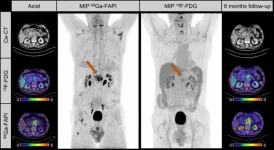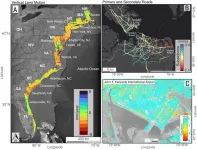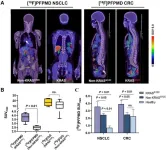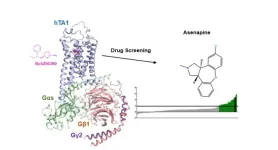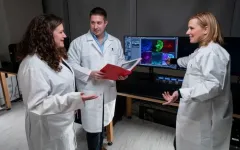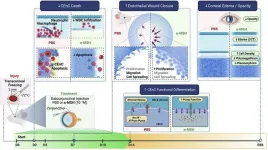(Press-News.org) Reston, VA—PET imaging with 68Ga-FAPI can more effectively detect and stage pancreatic cancer as compared with 18F-FDG imaging or contrast-enhanced CT, according to new research published in the December issue of The Journal of Nuclear Medicine. In a head-to-head study, 68Ga-FAPI detected more pancreatic tumors on a per-lesion, per-patient, or per-region basis and led to major and minor changes to clinical management of patients. In addition to enhancing precise detection of pancreatic cancer, 68Ga-FAPI imaging also paves the way for future targeted radiopharmaceutical therapies.
Approximately 64,000 Americans are diagnosed with pancreatic cancer each year. The disease is often diagnosed in advanced or metastasized stages and, as a result, is associated with extremely poor survival.
“Existing diagnostic approaches and workups are not sufficient for early detection of pancreatic cancer in curative stages for most patients,” said Jens T. Siveke, MD, translational and GI oncologist of the German Cancer Consortium (DKTK) at the West German Cancer Center in Essen, Germany. “Consequently, there is a pressing need for earlier and more precise disease detection, as well as a demand for novel targeted therapies.”
Recent studies have demonstrated high radiotracer uptake of 68Ga-FAPI in pancreatic cancer lesions; however, the precise diagnostic accuracy and the correlation of the tracer remain unexplored. In this study researchers sought to provide comprehensive data on the diagnostic performance of 68Ga-FAPI in pancreatic cancer patients.
Sixty-four patients with suspected or proven pancreatic cancer were included in the study. All patients underwent 68Ga-FAPI PET and contrast-enhanced CT, and 38 of the patients also underwent 18F-FDG PET. Researchers observed the association of the 68Ga-FAPI PET uptake intensity and histologic FAP (fibroblast activation protein) expression. The detection rate, diagnostic performance, inter-reader reproducibility, and change in management were also analyzed.
The association between 68Ga-FAPI PET uptake intensity and FAP expression was found to be significant, and 68Ga-FAPI PET showed high sensitivity and positive predictive values. In a head-to-head comparison with 18F-FDG and contrast-enhanced CE, 68Ga-FAPI PET detected more tumors on a per-lesion (84.7 vs. 46.5 vs. 52.9 percent), per-patient (97.4 vs. 73.7 vs. 92.1 percent), or per-region (32.6 vs. 18.8 vs. 23.7 percent) basis, respectively. 68Ga-FAPI PET readers showed substantial overall agreement, and minor and major changes in clinical management occurred in nearly 10 percent of patients after 68Ga-FAPI PET.
“Our research suggests that 68Ga-FAPI could become a building block in the diagnostic work-up of pancreatic cancer to improve early detection and accurate staging of this disease,” noted Lukas Kessler, MD, resident in the Department of Nuclear Medicine at University Hospital Essen in Germany. “Furthermore, our results support further investigation of FAP as a potential theranostic target of the tumor microenvironment, which represents an exciting new avenue in combating this enigmatic and fatal disease.”
This study was made available online in November 2023.
The authors of “68Ga-Labeled Fibroblast Activation Protein Inhibitor (68Ga-FAPI) PET for Pancreatic Adenocarcinoma: Data from the 68Ga-FAPI PET Observational Trial” include Lukas Kessler, Department of Nuclear Medicine, University Hospital Essen, University of Duisburg-Essen, Essen, Germany, Department of Diagnostic and Interventional Radiology and Neuroradiology, University Hospital Essen, Essen, Germany, and German Cancer Consortium (DKTK) (Partner Site University Hospital Essen) and German Cancer Research Center (DKFZ), Essen, Germany; Nader Hirmas, Ken Herrmann, and Wolfgang P. Fendler, Department of Nuclear Medicine, University Hospital Essen, University of Duisburg-Essen, Essen, Germany, and German Cancer Consortium (DKTK) (Partner Site University Hospital Essen) and German Cancer Research Center (DKFZ), Essen, Germany; Kim M. Pabst and Justin Ferdinandus, Department of Nuclear Medicine, University Hospital Essen, University of Duisburg-Essen, Essen, Germany, and Department of Diagnostic and Interventional Radiology and Neuroradiology, University Hospital Essen, Essen, Germany; Rainer Hamacher, German Cancer Consortium (DKTK) (Partner Site University Hospital Essen) and German Cancer Research Center (DKFZ), Essen, Germany, and Department of Medical Oncology, West German Cancer Center, University of Duisburg-Essen, Essen, Germany; Benedikt M. Schaarschmidt, Aleksander Milosevic, and Lale Umutlu, Department of Diagnostic and Interventional Radiology and Neuroradiology, University Hospital Essen, Essen, Germany, and German Cancer Consortium (DKTK) (Partner Site University Hospital Essen) and German Cancer Research Center (DKFZ), Essen, Germany; Michael Nader, Department of Nuclear Medicine, University Hospital Essen, University of Duisburg-Essen, Essen, Germany; Waldemar Uhl, Department of General and Visceral Surgery, St. Josef Hospital Bochum, Ruhr-University Bochum, Bochum, Germany; Anke Reinacher-Schick, Department of Hematology and Oncology with Palliative Care, St. Josef-Hospital, Ruhr-University Bochum, Bochum, Germany; Celine Lugnier, David Witter, and Marco Niedergethmann, Department of General and Visceral Surgery, Alfried Krupp Hospital, Essen, Germany; and Jens T. Siveke, German Cancer Consortium (DKTK) (Partner Site University Hospital Essen) and German Cancer Research Center (DKFZ), Essen, Germany, Bridge Institute of Experimental Tumor Therapy, West German Cancer Center, University Hospital Essen, University of Duisburg-Essen, Essen, Germany, and Division of Solid Tumor Translational Oncology, German Cancer Consortium (DKTK) (Partner Site University Hospital Essen) and German Cancer Research Center (DKFZ), Heidelberg, Germany.
Visit the JNM website for the latest research, and follow our new Twitter and Facebook pages @JournalofNucMed or follow us on LinkedIn.
###
Please visit the SNMMI Media Center for more information about molecular imaging and precision imaging. To schedule an interview with the researchers, please contact Rebecca Maxey at (703) 652-6772 or rmaxey@snmmi.org.
About JNM and the Society of Nuclear Medicine and Molecular Imaging
The Journal of Nuclear Medicine (JNM) is the world’s leading nuclear medicine, molecular imaging and theranostics journal, accessed 15 million times each year by practitioners around the globe, providing them with the information they need to advance this rapidly expanding field. Current and past issues of The Journal of Nuclear Medicine can be found online at http://jnm.snmjournals.org.
JNM is published by the Society of Nuclear Medicine and Molecular Imaging (SNMMI), an international scientific and medical organization dedicated to advancing nuclear medicine and molecular imaging—precision medicine that allows diagnosis and treatment to be tailored to individual patients in order to achieve the best possible outcomes. For more information, visit www.snmmi.org.
END
Ga-68 FAPI PET improves detection and staging of pancreatic cancer
2024-01-02
ELSE PRESS RELEASES FROM THIS DATE:
Understanding climate mobilities: New study examines perspectives from South Florida practitioners
2024-01-02
Understanding Climate Mobilities: New study examines perspectives from South Florida practitioners
As climate change continues to impact people across South Florida, the need for adaptive responses becomes increasingly important.
A recent study led by researchers at the University of Miami Rosenstiel School of Marine, Atmospheric, and Earth Science, assessed the perspectives of 76 diverse South Florida climate adaptation professionals. The study titled, “Practitioner perspectives on climate mobilities in South Florida” was published in the December issue of the Journal Oxford Open Climate Change, and explores the expectations and concerns of practitioners from the ...
Study: From NYC to DC and beyond, cities on the East Coast are sinking
2024-01-02
Major cities on the U.S. Atlantic coast are sinking, in some cases as much as 5 millimeters per year – a decline at the ocean’s edge that well outpaces global sea level rise, confirms new research from Virginia Tech and the U.S. Geological Survey.
Particularly hard hit population centers such as New York City and Long Island, Baltimore, and Virginia Beach and Norfolk are seeing areas of rapid “subsidence,” or sinking land, alongside more slowly sinking or relatively stable ground, increasing the risk to roadways, runways, building foundations, rail ...
New PET tracer noninvasively identifies cancer gene mutation, allows for more precise diagnosis and therapy
2024-01-02
Reston, VA—A novel PET imaging tracer has been proven to safely and effectively detect a common cancer gene mutation that is an important molecular marker for tumor-targeted therapy. By identifying this mutation early, physicians can tailor treatment plans for patients to achieve the best results. This research was published in the December issue of The Journal of Nuclear Medicine.
Kirsten rat sarcoma (KRAS) is a commonly mutated oncogene that is present in approximately 20-70 percent of cancer cases. Patients with KRAS mutations usually respond poorly to standard therapies. As such, the National Comprehensive ...
Evolution might stop humans from solving climate change, says new study
2024-01-02
Central features of human evolution may stop our species from resolving global environmental problems like climate change, says a new study led by the University of Maine.
Humans have come to dominate the planet with tools and systems to exploit natural resources that were refined over thousands of years through the process of cultural adaptation to the environment. University of Maine evolutionary biologist Tim Waring wanted to know how this process of cultural adaptation to the environment might influence the goal of solving global environmental problems. ...
January issues of APA journals cover antidepressant outcomes, disparities in school-based support, civil commitment hearings, and more
2024-01-02
WASHINGTON, D.C., Jan 2, 2024 — The latest issues of three American Psychiatric Association journals, The American Journal of Psychiatry, Psychiatric Services and The American Journal of Psychotherapy are now available online.
The January issue of The American Journal of Psychiatry features studies focusing on improving clinical outcomes and informing new interventions. Highlights include:
Predicting Acute Changes in Suicidal Ideation and Planning: A Longitudinal Study of Symptom Mediators and the Role of the Menstrual ...
Memory, brain function, and behavior: exploring the intricate connection through fear memories
2024-01-02
In a world grappling with the complexities of mental health conditions like anxiety, depression, and PTSD, new research from Boston University neuroscientist Dr. Steve Ramirez and collaborators offers a unique perspective. The study, recently published in the Journal of Neuroscience, delves into the intricate relationship between fear memories, brain function, and behavioral responses. Dr. Ramirez, along with his co-authors Kaitlyn Dorst, Ryan Senne, Anh Diep, Antje de Boer, Rebecca Suthard, Heloise ...
Demystifying a key receptor in substance use and neuropsychiatric disorders
2024-01-02
New York, NY (January 2, 2024)—Researchers at the Icahn School of Medicine at Mount Sinai have uncovered insights into the potential mechanism of action of the antipsychotic medication asenapine, a possible therapeutic target for substance use and neuropsychiatric disorders. This discovery may pave the way for the development of improved medications targeting the same pathway.
Their findings, detailed in the January 2 online issue of Nature Communications https://doi.org/10.1038/s41467-023-44601-4, show that a brain protein known as the TAAR1 receptor, a drug target known to regulate dopamine signaling in key reward pathways in the brain, differs ...
Elusive cytonemes guide neural development, provide signaling ‘express route’
2024-01-02
St. Jude Children’s Research Hospital scientists found that cytonemes (thin, long, hair-like projections on cells) are important during neural development. Cytonemes connect cells communicating across vast distances but are difficult to capture with microscopy in developing vertebrate tissues. The researchers are the first to find a way to visualize how cytonemes transport signaling molecules during mammalian nervous system development. The findings were published in Cell.
“We showed cytonemes are a direct express route for signal transport,” said corresponding author ...
Pioneering study indicates a potential treatment for corneal endothelial disease, reducing the need for corneal transplants
2024-01-02
Philadelphia, January 2, 2024 – Findings from a pioneering study in The American Journal of Pathology, published by Elsevier, reveal that administration of the neuropeptide α-melanocyte–stimulating hormone (α-MSH) promotes corneal healing and restores normal eye function to an otherwise degenerating and diseased cornea by providing protection against cell death and promoting cell regeneration.
Due to a lack of currently available medical therapy, patients suffering from corneal endothelial disease, ...
Diversity of bioluminescent beetles in Brazilian savanna has declined sharply in 30 years
2024-01-02
At night in the Cerrado, Brazil’s savanna and second-largest biome, larvae of the click beetle Pyrearinus termitilluminans, which live in termite mounds, display green lanterns to capture prey attracted by the bright light.
In more than 30 years of expeditions with his students to Emas National Park and farms around the conservation unit in Goiás state to collect specimens, the phenomenon has never been so rare, said Vadim Viviani, a professor at the Federal University of São Carlos’s Science and Technology for Sustainability Center (CCTS-UFSCar) in Sorocaba, São Paulo state.
“In the 1990s, we ...
